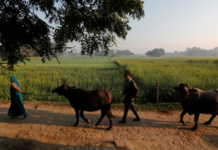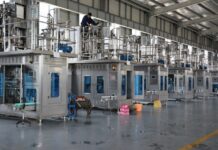New Delhi, December 24, 2021: Here’s a scenario farmers are all too often faced with – overcrowded barns. When milk prices see a boost, more animals tend to be added to the herd. When cull prices take a hit, lower producing animals seem to stick around a little longer. No matter what the situation might be, farmers are constantly faced with the headache of keeping the optimal number of animals in their herd without sacrificing productivity or cow comfort. But when do the barns become too full?
“Some farms achieve high milk production and have healthy cows with pens containing 40% more cows than stalls,” says Jim Salfer, extension dairy educator for the University of Minnesota. “Other farms have challenges if cows are overcrowded more than 10%. The answer to how much overcrowding is optimal depends on facility design and management.”
Know Where You Stand
Before you can determine your optimal stocking density, it’s important to know where you currently stand. To calculate this, take the number of cows within the facility and divide it by the number of stalls or lying spaces available. This will give you your current stocking ratio. However, it’s important to know that the number of stalls available is not the only limiting factor.
“Stocking density needs to be calculated in terms of each resource you provide your cows,” says Daniel Weary, extension educator at the University of British Columbia. “Comfortable lying space is key, but so is the amount of feeding space available. Many barns that are designed and managed to provide one stall per cow still provide too little feeding space. This means that cows can be well stocked for one resource (lying) but overstocked for another (feeding).”
Fit Your Cows Needs
In order for a cow to perform at her best, it’s important to give her the ability to rest. According to Salfer, dairy cows need 12-14 hours of rest each day, and this is optimized when they do not have to wait for a stall to lie down. High producing cows tend to spend most of their time in these key areas:
Cows will prioritize rest over all other daily activities, such as eating, drinking or socializing, in order to maximize their lying/resting time. However, if too many stalls are occupied, a cow may not be able to meet her rest requirements, causing milk production and cow comfort to plummet.
Often, the facilities we provide our cows with sometimes fail to meet their needs. Whether its inadequate bunk space, stall space or simply too many cows, chances are your facilities might need some fine tuning in order to fit a few additional animals according to the reports published in dairyherd.com.
According to Salfer, some questions to consider before bumping up your stocking density include:
Are the stalls comfortable?
“To achieve the desired lying time, all cows need access to high-quality beds,” Salfer says. “If stalls are too small, a cow lying in a stall may occupy part of a neighboring stall with its legs, head or back, which would prevent another cow from lying down in the vacant stall.”
Are first lactation cows separated from older cows?
First lactation cows tend to be smaller than their more mature herd mates. This makes it difficult for them to compete for bunk and bed space. According to Salfer, research shows a 10 to 15% improvement in milk yield and a nearly 20% increase in resting activity when first-calf heifers were grouped separately from older cows.
Is bunk space available?
“Lactating cows should have access to 24 inches of bunk space. This is seldom achieved with overstocking,” Salfer says. However, less bunk space can be partially compensated for with excellent feed management. This includes delivering feed to each pen within the same fifteen-minute window each day, keeping feed pushed up and be available for 24 hours and ensuring feed is uniformly delivered along the entire length of the bunk. (No part of the bunk should ever be out of feed.)
Take Action
“Overstocking increases competition for key resources and reduces the cow’s ability to lie down and to feed, especially at key times of the day when she is most highly motivated to engage in these activities,” Weary says. “Overstocking is especially harmful for the most vulnerable animals in our herd, including the sick and lame animals that are socially subordinate.”
Having too many animals can cause a mound of headaches for dairy producers and ultimately impacts their bottom line. However, poor facility design or management can also be to blame. Take time to evaluate your animals’ facilities to ensure it is fitting their spatial and time budgeting needs.




























